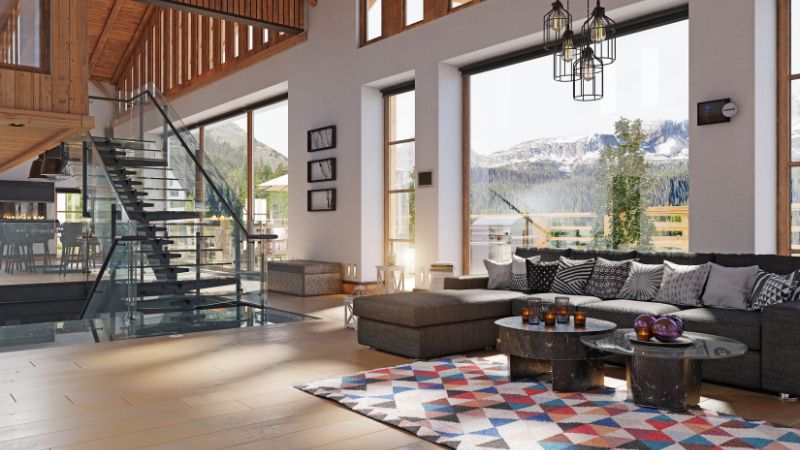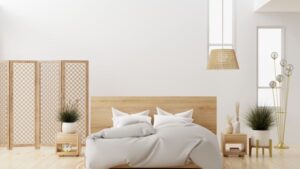Transforming a small home into a cozy and stylish space doesn’t have to break the bank. With the right approach, even a modest budget can go a long way in enhancing the look and feel of your living area. Whether you’re working with a tiny apartment or a compact house, there are plenty of creative and low-budget interior design ideas that can help you maximize space while reflecting your personal style. From clever storage solutions to DIY décor, you can achieve a high-end look without spending a fortune. In this blog, we’ll explore 10 affordable interior design ideas specifically tailored for small homes. These ideas will help you make the most of every square foot, turning your small space into a welcoming and functional haven. Get ready to embrace your inner designer and discover budget-friendly ways to revamp your home.
10 Low-Budget Interior Design Ideas For Small Homes
1. Maximize Natural Light
One of the most effective ways to make a small space feel larger and more inviting is to maximize natural light. Natural light not only brightens a room but also creates an open and airy atmosphere, making the space feel more expansive. To get started, take down the heavy drapes and replace them with lighter curtains that are sheer and allow sunlight to pass through. If you are concerned about privacy, you might want to think about using frosted window films, which allow light to enter while still maintaining privacy. Mirrors are yet another efficient tool that can be used to reflect natural light and give the impression that a room is quite larger. Put mirrors in the opposite direction of the windows to reflect light throughout the space. Additionally, consider using light-colored paint on your walls and ceilings, as darker hues can make a space feel smaller and more enclosed. The combination of natural light and a bright color palette will instantly make your small home feel larger, more cheerful, and welcoming.
2. Use Multifunctional Furniture
In small homes, every square inch counts, which is why multifunctional furniture is a game-changer. Pieces that serve multiple purposes help you save space without sacrificing functionality. For example, a sofa bed can serve as a comfortable seating area during the day and transform into a bed at night, making it perfect for small living rooms or guest rooms. Similarly, a coffee table with storage underneath can double as a place to store books, magazines, or blankets. Consider investing in a dining table that can fold away when not in use or ottomans that can be used as seating, storage, or even a coffee table. Murphy beds, which fold up into the wall, are another excellent option for small bedrooms. By choosing multifunctional furniture, you can maximize your living space while keeping your home clutter-free and stylish.
3. Incorporate Clever Storage Solutions
Clutter can make even the most spacious home feel cramped, so effective storage is essential in small spaces. The key is to think vertically and utilize every available nook and cranny. Install shelves high on the walls to store books, plants, or decorative items without taking up valuable floor space. Under-bed storage is another excellent solution for bedrooms; use shallow bins or drawers to keep out-of-season clothing or extra linens neatly tucked away. Consider using furniture with built-in storage, such as beds with drawers underneath or benches that open up to reveal hidden compartments. Pegboards in the kitchen or garage can keep tools and utensils organized while freeing up counter space. The backs of doors should not be overlooked; over-the-door organizers can store a wide variety of items, from shoes to cleaning supplies. By incorporating clever storage solutions, you can keep your small home organized and clutter-free while making the most of your available space.
4. Opt for Light Colors and Reflective Surfaces
Light colors are your best friend when decorating a small home, as they can make a room feel larger and more open. Soft neutrals, pastels, and whites reflect more light than darker colors, giving the illusion of more space. To enhance this effect, incorporate reflective surfaces like glass, mirrors, and glossy finishes. For example, a glass coffee table can create a sense of openness in a small living room, while a mirror on the wall can reflect light and make the room appear larger. In the kitchen, consider using white or light-colored cabinets with a glossy finish to brighten the space. Metallic accents, such as chrome or brass, can also add a touch of elegance and help bounce light around the room. By using a combination of light colors and reflective surfaces, you can create a brighter, more spacious atmosphere in your small home.
5. Embrace Vertical Design
It’s critical to think vertically when dealing with limited floor space. Because vertical design elements direct the viewer’s gaze upward, the space appears larger and the ceilings are higher. Start by incorporating tall furniture pieces, such as bookcases or wardrobes, that utilize the full height of your walls. Consider adding floor-to-ceiling curtains, which not only elongate the room but also add a touch of elegance. In the kitchen, install tall cabinets or open shelving to store items that you don’t use daily but still need to keep on hand. Vertical gardens, such as wall-mounted planters, are another excellent way to bring greenery into your home without taking up floor space. You can also use vertical space in the bathroom by adding shelves above the toilet or hooks on the back of the door. By embracing vertical design, you can make your small home feel taller, more open, and less cluttered.
Also Read:- Minimalist Home Interior Design Trends
6. Choose Compact and Foldable Furniture
In a small home, large, bulky furniture can overwhelm the space and make it feel cramped. Instead, opt for compact and foldable furniture that can be easily moved or stored away when not in use. For example, folding chairs and tables can be brought out when you have guests and then stored in a closet or under the bed when not needed. Stackable stools are another versatile option, providing extra seating without taking up much space. In the kitchen, a drop-leaf table can expand when you need more surface area but fold down to save space when you’re done. Nesting tables are also a great choice for small living rooms; they can be used separately or stacked together when not in use. By choosing compact and foldable furniture, you can make the most of your limited space while maintaining a clean and uncluttered look.
7. Create Zones Within Open Spaces
In small homes, open-concept layouts are common, but they can sometimes feel overwhelming without clear boundaries. Creating distinct zones within open spaces can help define different areas of your home, making it feel more organized and functional. Use rugs to delineate spaces, such as placing a rug under your dining table to separate it from the living area. Furniture arrangement is another way to create zones; for example, position your sofa and coffee table to create a cozy living room area separate from your workspace or dining area. You can also use room dividers, such as folding screens, bookcases, or curtains, to create a sense of separation without fully closing off the space. Additionally, consider using different lighting in each zone to further distinguish one area from another. By creating zones within open spaces, you can make your small home feel more structured and purposeful.
8. Personalize with DIY Decor
Adding a personal touch to your small home doesn’t have to be expensive. DIY decor allows you to express your style while keeping costs low. Whether you’re upcycling old furniture, creating your artwork, or crafting decorative items from inexpensive materials, there are countless ways to personalize your space on a budget. For example, you can transform an old dresser with a fresh coat of paint and new hardware or create a gallery wall with your favorite photos and prints. Handmade throw pillows, curtains, and blankets can also add color and texture to your home without breaking the bank. If you’re handy with tools, consider building your own furniture, such as a simple bookshelf or a coffee table made from reclaimed wood. Not only does DIY decor save money, but it also adds a unique, personalized touch to your home, making it truly your own.
9. Utilize Underused Spaces
In small homes, every square foot matters, so it’s essential to make the most of underused spaces. Areas like the space under the stairs, the tops of cabinets, or the corners of rooms can be transformed into functional areas with a little creativity. For example, the space under the stairs can be converted into a reading nook, a small home office, or additional storage with built-in shelves or cabinets. In the kitchen, use the tops of cabinets to store less frequently used items or to display decorative pieces. Corners of rooms can be utilized with corner shelves or small furniture pieces like a corner desk or a plant stand. Even the space above doors can be fitted with a shelf to store books or other items. By utilizing underused spaces, you can add functionality to your small home without adding clutter or compromising on style.
10. Keep It Simple and Minimalistic
When it comes to small spaces, less is often more. A minimalist approach to interior design can help keep your home feeling open, airy, and clutter-free. Focus on quality over quantity by selecting a few key pieces that serve a purpose and bring you joy. Avoid overcrowding your space with too much furniture or decor, as this can make the room feel cramped. Instead, opt for simple, clean lines and neutral colors that create a calming atmosphere. Decluttering regularly is also essential in maintaining a minimalist space; be mindful of what you bring into your home and make sure it adds value to your life. Incorporate plenty of open space in your design, allowing your home to breathe and making it easier to move around. By keeping your design simple and minimalistic, you can create a peaceful, functional, and stylish small home that feels much larger than it is.
Conclusion
Designing a small home on a budget is all about creativity and smart choices. By incorporating these low-budget interior design ideas, you can create a stylish and comfortable space that reflects your personality without overspending. From using mirrors to create the illusion of space to opting for multifunctional furniture, these tips are perfect for maximizing both style and function in a compact home. Remember, a little imagination goes a long way in making your small home feel bigger and more inviting. Start transforming your space today with these affordable ideas!
FAQs
How can I make a small home look bigger on a budget?
Use light colors, mirrors, and smart storage solutions to create the illusion of more space without spending much.
What are some budget-friendly ways to decorate a small home?
Consider DIY projects, thrift store finds, and multifunctional furniture to decorate stylishly on a budget.


